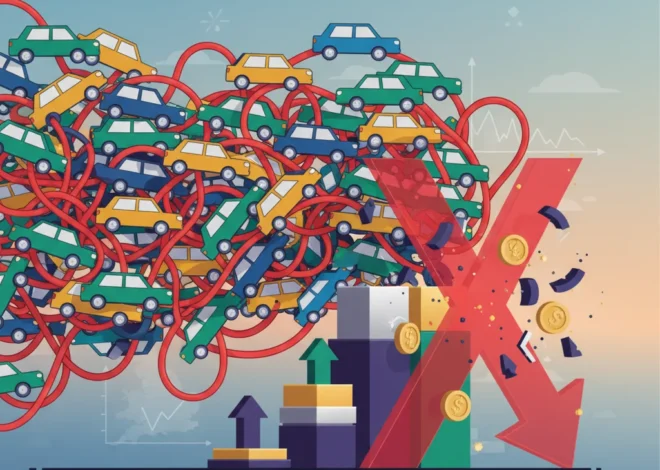
The Penny Paradox: Why a Coin Shortage Signals a Revolution in Finance and the Economy
“Find a penny, pick it up, all the day you’ll have good luck.” It’s a timeless piece of folklore, but what happens when you can’t find a penny in the first place? Across the United States, businesses are grappling with a peculiar and frustrating problem: a shortage of coins, most notably the humble penny. This isn’t just an inconvenience for cashiers and customers; it’s a powerful symptom of a profound transformation sweeping through our financial landscape. The scarcity of this one-cent coin is a small-scale manifestation of large-scale shifts in the economy, banking, and the very nature of money itself.
Contrary to some circulating rumors, the issue isn’t that the U.S. Mint has ceased production. In fact, it continues to churn out billions of coins each year. The real story, as highlighted in a recent BBC report, is a crisis of circulation. The pandemic dramatically altered consumer behavior, accelerating the shift to digital and contactless payments. Coins that once flowed freely from pockets to cash registers to banks and back again now sit idle in piggy banks, car cup holders, and forgotten jars. This logistical breakdown has exposed the deep-seated inefficiencies of our physical currency system and reignited a decades-old debate about the penny’s place in modern economics.
In this analysis, we will dissect the anatomy of the great American coin shortage, explore the controversial economics of the penny, and examine the far-reaching implications for investors, business leaders, and the future of financial technology.
The Anatomy of a Shortage: A Logistical Puzzle, Not a Production Problem
To understand the current coin crunch, one must first dismiss the notion that the government has simply stopped making them. The U.S. Mint is very much active. In 2022 alone, the Mint produced over 13.6 billion circulating coins, with pennies accounting for a significant portion of that volume. The problem lies in the velocity of money—specifically, the velocity of physical coins.
The U.S. Federal Reserve established the U.S. Coin Task Force in 2020 to address this very issue. Their findings pointed to a perfect storm of factors disrupting the normal flow of coinage:
- Shifting Payment Habits: The most significant driver is the widespread adoption of credit cards, debit cards, and digital wallets. Consumers are simply using cash less frequently, meaning coins aren’t being reintroduced into the system.
- Pandemic Accelerants: The COVID-19 pandemic acted as a powerful catalyst. Health concerns over handling cash, coupled with the boom in e-commerce and delivery services, broke the traditional cash-cycle chain.
- Bank Branch Closures: A consolidation in the banking industry has led to fewer physical bank branches, which have historically served as primary conduits for coin deposits and distribution.
- Coin Hoarding: As coins sit in households, they are effectively removed from active circulation. Billions of dollars in coinage are estimated to be out of the active economy at any given time.
This circulation bottleneck creates a significant operational headache for cash-reliant businesses, particularly small retailers, laundromats, and restaurants, forcing them to spend time and resources hunting for rolled coins or encouraging customers to use exact change or alternative payment methods.
Beyond the Banners: What the Edinburgh Protests Mean for the Global Economy and Your Portfolio
The Troubled Economics of the One-Cent Coin
The circulation crisis has brought a much older and more fundamental issue back into the spotlight: the questionable economics of the penny itself. For over a decade, the cost to produce and distribute a one-cent coin has exceeded its face value. This phenomenon, where a government loses money minting currency, is the opposite of “seigniorage,” the profit a state makes from issuing currency.
According to the U.S. Mint’s 2023 Annual Report, the unit cost to produce a penny was 3.07 cents. This means for every penny minted, the U.S. taxpayer loses over two cents. When multiplied by the billions of pennies produced each year, this amounts to a significant and persistent financial loss for the government.
Here is a look at the rising cost of penny production over the past few years, illustrating the growing economic inefficiency.
| Fiscal Year | Cost to Produce a Penny (in cents) |
|---|---|
| 2020 | 1.76 |
| 2021 | 2.10 |
| 2022 | 2.72 |
| 2023 | 3.07 |
Data sourced from U.S. Mint annual reports.
This negative seigniorage is a direct subsidy for the metals industry (pennies are primarily made of zinc, coated in copper) at the expense of the public treasury. The resources, energy, and logistics involved in creating and transporting billions of low-value metal discs represent a substantial misallocation of economic resources in an increasingly digital world.
The Great Penny Debate: A Century of Controversy
The discussion over eliminating the penny is hardly new, but the current shortage has given it fresh urgency. Proponents and opponents have well-established arguments, creating a political and economic stalemate. Several other developed nations, including Canada, Australia, and New Zealand, have successfully eliminated their lowest-denomination coins, offering a blueprint for a potential transition.
To clarify the debate, let’s compare the primary arguments for and against retiring the one-cent coin.
| Arguments for Eliminating the Penny | Arguments for Keeping the Penny |
|---|---|
| Economic Inefficiency: It costs far more to produce than it’s worth, leading to taxpayer losses of tens of millions annually. | Rounding Concerns: Opponents fear merchants will round prices up, creating a hidden “inflation tax” on consumers. (Studies from other countries have shown this impact to be negligible). |
| Wasted Time & Productivity: Counting pennies slows down transactions, creating a cumulative drag on economic productivity. | Impact on Charities: Many charities rely on coin jar donations, and the penny is a significant part of that. |
| Environmental Impact: Mining zinc and copper, plus the energy for minting and transportation, has a real environmental cost for a coin with little purchasing power. | Tradition & Nostalgia: The penny, featuring Abraham Lincoln, is an iconic piece of American currency and history. |
| Simplification of Commerce: Eliminating the penny streamlines accounting and cash handling for businesses. | Pricing Precision: It allows for exact pricing (e.g., $9.99), which is a key psychological tool in marketing. |
Economic Archetypes: What Spongers, Spendthrifts, and Billionaires Reveal About Our Financial World
Broader Implications for Finance, Investing, and the Economy
The penny problem is a microcosm of the larger digital disruption transforming the financial sector. Its implications extend far beyond the cash register and offer insights for strategic business planning and investment theses.
For Business Leaders and the Banking Sector:
The coin shortage is a clear signal that reliance on physical cash is becoming a liability. Businesses must accelerate their adoption of diverse payment systems. This means investing in modern point-of-sale (POS) technology that seamlessly integrates tap-to-pay, mobile wallets, and other forms of digital transaction. For the banking industry, it underscores the need to innovate beyond traditional services. The future lies in robust digital platforms, instant payment networks, and services that cater to a less-cash-intensive economy.
For Investors and the Stock Market:
This trend is a powerful tailwind for the financial technology sector. Investors should view the decline of cash as a long-term growth driver for companies specializing in:
- Payment Processing: Companies like Visa, Mastercard, PayPal, and Block (formerly Square) are at the heart of this transition.
- Fintech Infrastructure: Firms that provide the software and hardware for digital banking, mobile payments, and secure online transactions.
- Trading and Digital Assets: While distinct from retail payments, the broader conversation about the nature of currency also fuels interest in the future of trading and the potential tokenization of assets. Some even see this as a step toward normalizing the idea of purely digital currencies, potentially opening doors for technologies like blockchain to be integrated into mainstream finance, such as in the development of Central Bank Digital Currencies (CBDCs).
Conversely, industries dependent on the cash economy, such as armored transport services and physical ATM manufacturing, may face secular headwinds. The key for savvy investing is to identify the innovators enabling this transition, not the incumbents being disrupted by it.
Hong Kong's New Highs: Reading the Economic Tea Leaves in a City Reborn
A Bellwether for the Future of Money
The great penny shortage of the 2020s will likely be remembered not as a standalone event, but as a pivotal moment in the evolution of money. It is a tangible, everyday example of how technological advancement and changing social habits can render parts of our established economic infrastructure obsolete. While the fate of the penny remains a matter of political debate, the direction of the economy is clear. We are moving toward a faster, more efficient, and overwhelmingly digital financial future.
Whether you are a consumer, a business owner, or an investor, the message is the same: the ground is shifting beneath our feet. The disappearance of the penny from our daily transactions is not just a story about coins; it’s a story about the relentless march of economic and technological progress.


